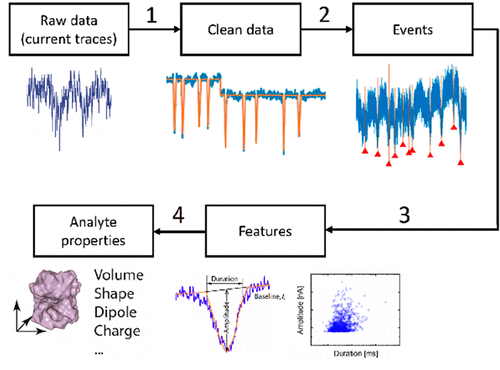Our official English website, www.x-mol.net, welcomes your
feedback! (Note: you will need to create a separate account there.)
A Guide to Signal Processing Algorithms for Nanopore Sensors
ACS Sensors ( IF 8.2 ) Pub Date : 2021-10-04 , DOI: 10.1021/acssensors.1c01618 Chenyu Wen 1 , Dario Dematties 2 , Shi-Li Zhang 1
ACS Sensors ( IF 8.2 ) Pub Date : 2021-10-04 , DOI: 10.1021/acssensors.1c01618 Chenyu Wen 1 , Dario Dematties 2 , Shi-Li Zhang 1
Affiliation

|
Nanopore technology holds great promise for a wide range of applications such as biomedical sensing, chemical detection, desalination, and energy conversion. For sensing performed in electrolytes in particular, abundant information about the translocating analytes is hidden in the fluctuating monitoring ionic current contributed from interactions between the analytes and the nanopore. Such ionic currents are inevitably affected by noise; hence, signal processing is an inseparable component of sensing in order to identify the hidden features in the signals and to analyze them. This Guide starts from untangling the signal processing flow and categorizing the various algorithms developed to extracting the useful information. By sorting the algorithms under Machine Learning (ML)-based versus non-ML-based, their underlying architectures and properties are systematically evaluated. For each category, the development tactics and features of the algorithms with implementation examples are discussed by referring to their common signal processing flow graphically summarized in a chart and by highlighting their key issues tabulated for clear comparison. How to get started with building up an ML-based algorithm is subsequently presented. The specific properties of the ML-based algorithms are then discussed in terms of learning strategy, performance evaluation, experimental repeatability and reliability, data preparation, and data utilization strategy. This Guide is concluded by outlining strategies and considerations for prospect algorithms.
中文翻译:

纳米孔传感器信号处理算法指南
纳米孔技术在生物医学传感、化学检测、海水淡化和能源转换等广泛应用中具有广阔的前景。特别是对于在电解质中进行的传感,有关易位分析物的大量信息隐藏在由分析物与纳米孔之间的相互作用产生的波动监测离子电流中。这种离子电流不可避免地受到噪声的影响;因此,信号处理是传感不可分割的组成部分,以便识别信号中隐藏的特征并对其进行分析。本指南首先理清信号处理流程,并对为提取有用信息而开发的各种算法进行分类。通过对基于机器学习 (ML) 和非基于机器学习 (ML) 的算法进行分类,可以系统地评估其底层架构和属性。对于每个类别,通过参考图表中以图形方式总结的常见信号处理流程,并通过突出显示其关键问题以进行清晰比较,讨论了算法的开发策略和特征以及实现示例。随后介绍了如何开始构建基于 ML 的算法。然后从学习策略、性能评估、实验重复性和可靠性、数据准备和数据利用策略等方面讨论基于机器学习的算法的具体属性。本指南的最后概述了前景算法的策略和注意事项。
更新日期:2021-10-22
中文翻译:

纳米孔传感器信号处理算法指南
纳米孔技术在生物医学传感、化学检测、海水淡化和能源转换等广泛应用中具有广阔的前景。特别是对于在电解质中进行的传感,有关易位分析物的大量信息隐藏在由分析物与纳米孔之间的相互作用产生的波动监测离子电流中。这种离子电流不可避免地受到噪声的影响;因此,信号处理是传感不可分割的组成部分,以便识别信号中隐藏的特征并对其进行分析。本指南首先理清信号处理流程,并对为提取有用信息而开发的各种算法进行分类。通过对基于机器学习 (ML) 和非基于机器学习 (ML) 的算法进行分类,可以系统地评估其底层架构和属性。对于每个类别,通过参考图表中以图形方式总结的常见信号处理流程,并通过突出显示其关键问题以进行清晰比较,讨论了算法的开发策略和特征以及实现示例。随后介绍了如何开始构建基于 ML 的算法。然后从学习策略、性能评估、实验重复性和可靠性、数据准备和数据利用策略等方面讨论基于机器学习的算法的具体属性。本指南的最后概述了前景算法的策略和注意事项。











































 京公网安备 11010802027423号
京公网安备 11010802027423号